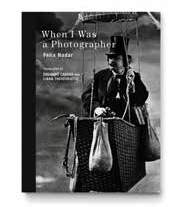When I Was a Photographer
Although Nadar’s book, which had originally come out 115 years before the current English translation, is most frequently characterized as memoirs, the style of the text differs from chapter to chapter: direct speech is interspersed with detailed descriptions of Paris in that period and passages of pure poetry. The reader gets a sense of “watching live” the changing role of photography in the 19th century, as the original misgivings regarding the new invention give way to a rising confidence in the new medium. The 19th century comes through in Nadar’s writing as a celebration of science. On several occasions, Nadar details various new inventions and their creators, noting with admiration the benefits of these innovations. Nadar explored the technical possibilities of photography not only in theory, but also in practice, setting up his equipment in an air balloon, or experimenting with artificial lighting to photograph in catacombs. Keenly aware of the limitations inherent to the photographic devices, he nonetheless firmly believed in future progress. Among other things he prophesied that one day his followers will be able to carry their “laboratory” in their pocket. The book is also peppered with “anecdotes from the studio”, as Nadar describes the reactions of his clients when he first showed them their photographic portraits. Two chapters in particular are riveting in terms of language, with some fascinating turns of phrase: Homicidal Photography tells the thrilling story of a newspaper photograph of a murder victim. The photograph here testifies not only to a murder, but also to the eternal human thirst for lurid sensationalism. The other, a rather rambling chapter titled 1830 and Thereabouts, presents a vivid picture of 19th century Paris in all its vibrant diversity. At times bordering on caricature1 Nadar describes the Parisian street mobs, its flaneurs and picturesque characters in the tumult of everyday life, its boulevards, shops, garbage, its businessmen, chancers, refugees and even animals. Nadar’s account of the century in which photography was invented and became defined as a medium is breathtaking. Rambling and digressive it sometimes becomes difficult to follow – the introduction as a matter of fact describes Nadar’s writing as “neustálé ztrácení a znovu nacházení se”. It is these very qualities of digression and elusiveness that captivated Walter Benjamin who often quoted Nadar’s writing. The Bohemian life of Paris and its teeming bustle are evoked most vividly in Nadar’s book as well as in his portraits, as if coming to life before our very eyes – for people remain essentially the same, whether with a laboratory in their pocket on in a large studio.
Tereza Špinková
Nadar, Félix. When I Was a Photographer. Cambridge: The MIT Press, 2015. ISBN: 9780262029452.
1 Alongside photography Nadar in fact also actively pursued caricature.
#30 eye in the sky
Archive
- #45 hypertension
- #44 empathy
- #43 collecting
- #42 food
- #41 postdigital photography
- #40 earthlings
- #39 delight, pain
- #38 death, when you think about it
- #37 uneven ground
- #36 new utopias
- #35 living with humans
- #34 archaeology of euphoria
- #33 investigation
- #32 Non-work
- #31 Body
- #30 Eye In The Sky
- #29 Contemplation
- #28 Cultura / Natura
- #27 Cars
- #26 Documentary Strategies
- #25 Popular Music
- #24 Seeing Is Believing
- #23 Artificial Worlds
- #22 Image and Text
- #21 On Photography
- #20 Public Art
- #19 Film
- #18 80'
- #17 Amateur Photography
- #16 Photography and Painting
- #15 Prague
- #14 Commerce
- #13 Family
- #12 Reconstruction
- #11 Performance
- #10 Eroticon
- #9 Architecture
- #8 Landscape
- #7 New Staged Photography
- #6 The Recycle Image
- #5 Borders Of Documentary
- #4 Intimacy
- #3 Transforming Of Symbol
- #2 Collective Authorship
- #1 Face

